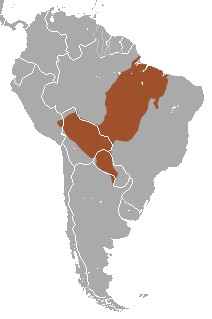Azara's night monkey
| Azara's night monkey[1] | |
|---|---|

| |
| Azara's night monkey (A. a. infulatus) at Cristalino Jungle Lodge, Mato Grosso, Brazil | |
| Scientific classification | |
| Domain: | Eukaryota |
| Kingdom: | Animalia |
| Phylum: | Chordata |
| Class: | Mammalia |
| Order: | Primates |
| Suborder: | Haplorhini |
| Infraorder: | Simiiformes |
| Family: | Aotidae |
| Genus: | Aotus |
| Species: | A. azarae
|
| Binomial name | |
| Aotus azarae (Humboldt, 1811)
| |

| |
| Azara's night monkey range | |
Azara's night monkey (Aotus azarae), also known as the southern night monkey, is a
Taxonomy
There are three subspecies of Azara's night monkey.[1]
- Aotus azarae azarae
- Bolivian night monkey, Aotus azarae boliviensis
- Feline night monkey, Aotus azarae infulatus
Physical characteristics

Due to a lack of data body size and weight measurements of Azara's night monkey have been estimated from a small number of wild samples. The average head and body length of the female is 341 mm (13.4 in) while the male is 346 mm (13.6 in).[citation needed] The average weight is 1,254 g (2.765 lb) for male A. a. azarae, 1,246 g (2.747 lb) for female A. a. azarae, 1,180 g (2.60 lb) for male A. a. boliviensis, and 1,230 g (2.71 lb) for female A. a. boliviensis.[3] Its gestation period is about 133 days. The lifespan for Azara's night monkey is unknown, but the captive life span for members of the genus Aotus is believed to be 20 years.[3]
Behavior and ecology
Azara's night monkey is a monogamous species, with the male remaining present to raise the offspring and provide food. The offspring will only stay with its family until two to three years of age and then will disperse to begin a family of its own. There is very little sexual dimorphism in this species.[3]
Azara's night monkey is primarily a frugivore, but also will eat things such as leaves, flowers, and insects. One of the main advantages of being a nocturnal animal is that there is greatly reduced competition from diurnal animals.[3]
Azara's night monkey spends its life in trees and becomes more active when the moon is brighter, tending to keep to its well-known paths. However, uniquely among night monkeys, populations of Azara's night monkey from the Gran Chaco are active both day and night.[2] Azara's night monkey can be found sleeping in groups of between 2 and 5 others in trees. The average group size is about 3 monkeys, consisting of an adult pair and their offspring. It leaps from tree to tree but also moves quadrupedally throughout the forest.[3]
Habitat and distribution
Azara's night monkey is found in northern
Conservation
Azara's night monkey is widespread and believed to be overall fairly common. It is present in several reserves. The species is not considered threatened, but is declining locally due to habitat loss.[2]
References
External links
- Aotus azarae information at ThePrimata.
- Aotus: The Owl Monkey's Natural History at MD Anderson.

